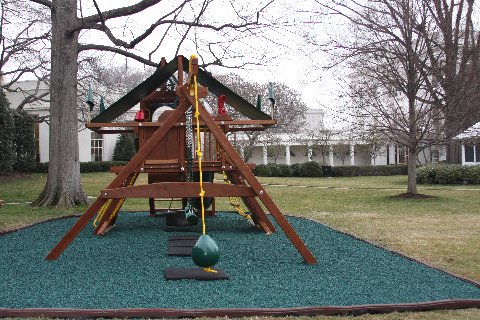Playgrounds should be fun AND relatively safe places for kids and adults to enjoy
We recently blogged about concerns surrounding artificial turfs (with Gifs!), and a particular type of artificial turf has raised quite a few concerns- crumb rubber. Developed in the mid-1960s, synthetic turfs began popping up in stadiums and fields for professional teams. Now synthetic turfs have become more widespread, being used in parks, golf courses, playgrounds, and even cruise ships.
But with high levels of lead being found in some crumb rubber turfs, concerns are valid. Made from recycled tires, several different brands of tires can be found in one field. The EPA indicated that mercury, lead, benzene, polycyclic aromatic hydrocarbons, arsenic, and other heavy metals and carcinogens, to name a few, have been found in tires.
Old tires pile up in landfills and may cause numerous environmental concerns as they sit for years. Figuring out what to do with this waste is tough, but using them in fields frequently used by children isn’t the answer. Children’s young growing bodies are more susceptible to toxic chemical exposure and with ingredients like lead, mercury, and other heavy metals… caution is necessary.
So we’re focusing on crumb rubber turfs in particular this time
Kids love and need to get regular outside exercise. Remember indoor recess? Yeah, it was horrible.
So what do you need to know?
Synthetic turf proponents claim that there’s no evidence of health effects. Research director of the Center for Environmental Health, Caroline Cox, believes that although the science isn’t conclusive, toxic chemicals are in fact present in synthetic turf.
So, dozens of cities are standing up to block the installation of the potentially harmful surfaces. New York State banned crumb rubber from all future artificial turf installations in 2008. A state senator in California wants to ban recycled tires from being used in synthetic turfs, too.
Last Spring, several current and former soccer goalkeepers were diagnosed with rare cancers. All of these athletes played on artificial turfs that contained crumb rubber from recycled tires.
What are the alternatives?
Some companies are using quartz in a sand-like consistency that holds up to heat better than the rubber and is approved by the FDA. Let’s not forget that natural grass fields are an option as well.
- It’s cheaper– Premium organic renovation with real grass would cost approximately $300,000
- It is cheaper in the long-run too! With high quality seeds and care, maintenance costs usually decrease over time.
- It doesn’t use as much water as one might think– With the right seed and weather, one may be able to decrease water usage for real grass.
For more information on the benefits of natural grass lawns, check out our blog, “Get Off Our Toxic Turf Toxic Chemicals,” by Joan Spoerl.
What can you do?
- Teachers, childcare providers and parents should make sure that children wash their hands thoroughly after playing outside.
- Make sure that kids don’t sit or lay down on the synthetic turfs to limit their exposure to the recycled rubber.
- Don’t forget about your pets! Pets may fare better on natural grass fields, since they are closer to the ground and can potentially ingest the crumbs.
- Avoid synthetic fields especially on hot days. On hot days, gases can be emitted from the fields.
- Take better care of the tires on your car. We can reduce the amount of scrap tires every year by purchasing high-mileage tires, monitoring air pressure, rotating tires, and not forgetting to schedule regular wheel alignments.
Recycling materials sounds good for the environment, but not when hazardous chemicals are being reintroduced through recycling. More research needs to be done. In the meantime keep these tips in mind and find a natural grass field that doesn’t use harsh pesticides.
For more information. check out this report from Environment and Human Health, Inc., a nonprofit environmental health group, “Artificial Turf: Exposures to Ground Up Rubber Tires.”
Kids need to get outside and play! There are plenty of risks kids have to face when they’re going outside.
Kids will fall, they’ll get hurt- it happens. But toxic chemical exposure from crumb rubber fields can be avoided.




